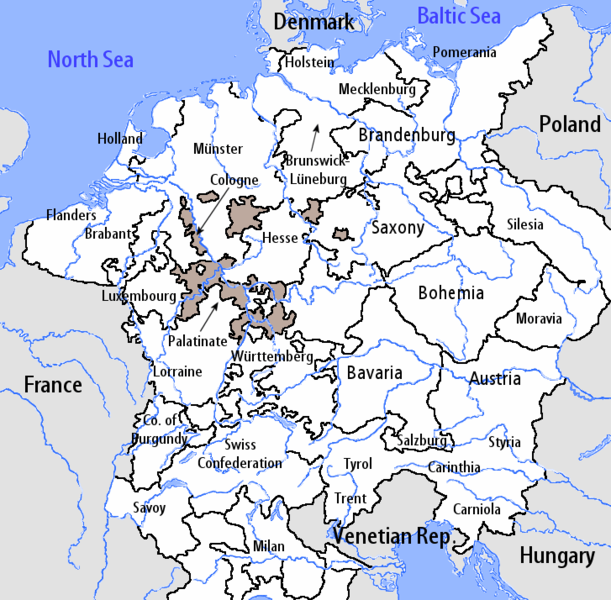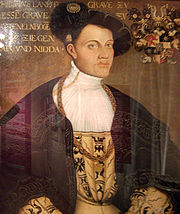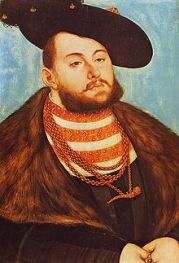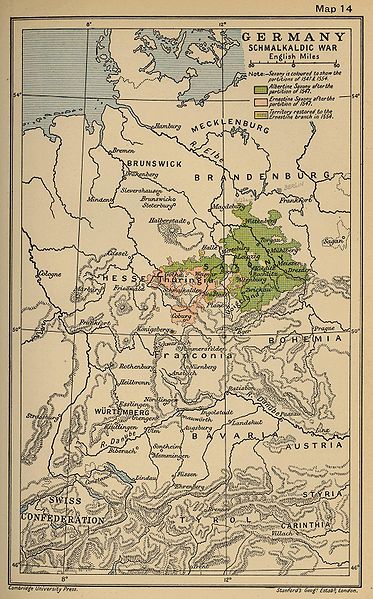The Schmalkaldic League
Jump to navigation
Jump to search
| What was the Schmalkaldic League? |
| This was both a political and religious defensive alliance during the Reformation which was formed by the Protestant territories of the Holy Roman Empire to defend themselves collectively against any attempt to enforce the recess of the Diet of Augsburg in 1530, which gave the Protestant territories a deadline by which to return to Catholic practices. |
| Origins and Leaders |
| Established in February 1531 at Schmalkalden, Germany, the league was led by Philip I, Landgrave of Hesse and John Frederick 1, Elector of Saxony (who was married to Anne of Cleves sister Sybille). Among its other original members were Brunswick, Anhalt, and the cities of Mansfeld, Magdeburg, Bremen, Strassburg, and Ulm. Philip of Hesse and John Frederick 1 of Saxony |
| Members |
The parties to it were:
|
 The Crisis caused by the reformation mean that many local dukes saw it as a chance to oppose the hegemony of Emperor Charles V. The empire then became fatally divided along religious lines, with the North, the East, and many of the major cities— Strasbourg, Frankfurt and Nuremberg—eventually becoming Protestant while the southern and western regions largely remained Catholic. |
| Smalcald Articles or Schmalkald Articles |
| a summary of Lutheran doctrine, written by Martin Luther in 1537 for a meeting of the League in preparation for an intended ecumenical Council of the Church. The league ultimately determined not to adopt the articles Luther had written. They were influenced not to adopt the Smalcald Articles by Philipp Melanchthon, who was concerned that Luther's writing would be regarded as divisive by some. Melanchthon was asked to write a clear statement on the Papacy and this he did, a document that was adopted at the meeting as the Treatise on the Power and Primacy of the Pope. |
| Luther summarized what he regarded to be the most important teaching in Christianity: The first and chief article is this: Jesus Christ, our God and Lord, died for our sins and was raised again for our justification (Romans 3:24–25). He alone is the Lamb of God who takes away the sins of the world (John 1:29), and God has laid on Him the iniquity of us all (Isaiah 53:6). The Smalcald Articles holds to the controversial view that the Pope is the Antichrist, a view which later became an article of faith in many Lutheran churches. [...]the Pope is the very Antichrist, who has exalted himself above, and opposed himself against Christ because he will not permit Christians to be saved without his power, which, nevertheless, is nothing, and is neither ordained nor commanded by God. ... |
| Timeline |
| 1517 - After Luther ignited a massive religious debate via the publication of his 95 Theses, many German territories adopted his ideas and converted away from the existing Catholic Church. However, the Empire was an intrinsically Catholic institution, and the Emperor Charles V was the secular head of a Catholic Church that now regarded Luther's ideas as heresy |
| 1521 - Emperor Charles V pledged to remove the Lutherans (this new branch of religion was not yet called Protestantism) from his kingdom, with force if necessary. Throughout the 1520's Charles needed their support - militarily, politically and economically - and he was thus prevented from acting against them. Consequently, Lutheran ideas continued to spread amongst the German territories. |
| 1529 - 1530 - Charles V had renewed his peace with France in 1529, temporarily driven the Ottoman forces back, and settled matters in Spain; he wanted to use this hiatus to reunite his empire, so it was ready to face any renewed Ottoman threat. Additionally, he had just returned from Rome having been crowned Emperor by the Pope, and he wanted to end the heresy |
| June 1530 - The Confession of Augsburg. Philip Melanchthon prepared a statement defining the basic Lutheran ideas, which had now been refined by nearly two decades of debate and discussion. However, for many Catholics there could be no compromise with this new heresy, and they presented a rejection of the Lutheran Confession entitled The Confutation of Augsburg. Despite it being very diplomatic - Melanchthon had avoided the most contentious issues and focused on areas of probable compromise - the Confession was rejected by Charles V. He instead accepted the Confutation, consented to a renewal of the Edict of Worms (which banned Luther's ideas), and gave a limited period for the 'heretics' to reconvert. The Lutheran members of the Diet left, in a mood which historians have described as both disgust and alienation. |
| *December 1530 - In a direct reaction to the events of Augsburg two leading Lutheran princes, Landgrave Philip of Hesse and Elector John of Saxony, arranged a meeting at Schmalkalden, Hesse-Nassau. |
| 1531 - 8 princes and 11 cities agreed to form a defensive league: if one member were attacked because of their religion, all the others would unite and support them. The Confession of Augsburg was to be taken as their statement of faith, and a charter drawn up. Additionally, a commitment to provide troops was established, with a substantial military burden of 10,000 infantry and 2,000 cavalry being split amongst the members. |
| 1535 - Francis I of France joined the League against the Habsburgs, but later retracted due to religious conflicts from within. |
| 1537 -Martin Luther writes the Schmalkald Articles |
| 1538 - The league allied with the newly reformed Denmark. |
| 1538 - In self-defence against the treasonable machinations of the confederation, a Catholic League was formed at Nuremberg under the leadership of the emperor Charles V. |
| 1539 - the League acquired Brandenburg which was under the leadership of Joachim II Hector |
| 1540 - 1543 - Philip of Hesse was revealed to be a bigamist, a crime punishable by death under the Empire's legal Code of 1532. Fearing for his life, Philip sought an Imperial pardon, and when Charles agreed Philip's political strength was shattered; the League lost an important leader. |
| 1544 - Denmark and the Holy Roman Empire signed the Treaty of Speyer, which stated that during the reign of Christian III of Denmark, Denmark would maintain a peaceful foreign policy towards the Holy Roman Empire |
| 1545 - the League gained the allegiance of the Electoral Palatinate, under the control of Elector Frederick III |
| 1545 - by this date all of the northern Empire was Lutheran, and numbers were growing in the south. While the Schmalkaldic League never included all of the Lutheran territories - many cities and princes remained separate - it did form a core amongst them. |
| 1544 - Charles V worked to end the League's foreign support, and signed the Peace of Crècy with Francis I, whereby the French King agreed not to ally with Protestants from within the Empire. This included the Schmalkaldic League. Emperor Charles V also began to seek allies amongst the Lutheran princes, exploiting their secular differences, and his two greatest coups were Maurice, the Duke of Saxony, and Albert, Duke of Bavaria. Maurice hated his cousin John, who was both the Elector of Saxony and a leading member of the Schmalkaldic League; Charles promised all of John's lands and titles as a reward. Albert was persuaded by an offer of marriage: his eldest son for the Emperor's niece. |
| 1546 - Charles V took advantage of a truce with the Ottomans and gathered an army, drawing troops from across the Empire. The Pope also sent support, in the form of a force led by his grandson. While the League was quick to muster, there was little attempt to defeat any of the smaller units before they had combined under Charles. |
| 1546-7 - The Schmalkaldic War was fought between these dates. The League may have had more troops, but they were dis-organised, and Maurice effectively split their forces when his invasion of Saxony drew John away. Ultimately, the League was beaten easily by Charles V at the Battle of Mühlberg, where he crushed the Schmalkaldic army and captured many of its leaders. John and Philip of Hesse were imprisoned, the Emperor stripped 28 cities of their independent constitutions, and the League was finished. |


